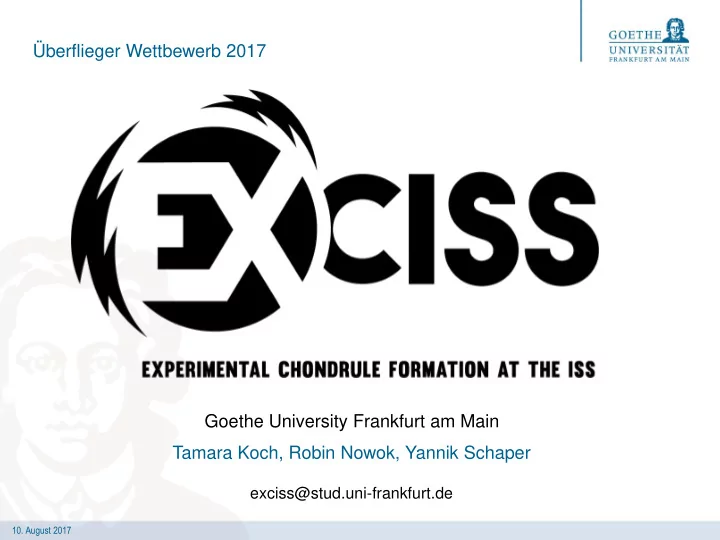

Überflieger Wettbewerb 2017 Goethe University Frankfurt am Main Tamara Koch, Robin Nowok, Yannik Schaper exciss@stud.uni-frankfurt.de 10. August 2017
EXCISS Team Y. Schaper (Physics) O. Christ (Mineralogy) M. Lindner (Geoscience) F. Schmuck (Geoscience) P.-T. Genzel (Mineralogy) S. Rempt (Mineralogy) Y. Matschey (Geoscience) D. Mederos Leber (Physics) R. Nowok (Mineralogy) A. Beck (Geochemistry) T. Koch (NanoGeoscience) 10. August 2017 2
Introduction Chondrules • One of the oldest materials in our solar system • Building blocks for the planetary system How did the first solid particles of our solar system form? • Is the answer in the chondrules? “(… ) meteoritics who know chondrules must collaborate with astrophysicists who know what it was like at the beginning of our solar system. ” Kerr, Science (2013) 10. August 2017 3
What are Chondrules? crystallized from a melt (> 2000 K) oldest material in Ø mm-sized our solar system spherical objects building blocks for consist of the planetary system silicates and metal Summarized in Zanda, Earth & Planetary Science Letters (2004) Video: NASA's Goddard Space Flight Center Conceptual Image Lab 10. August 2017 4
“We all know how chondrules are formed – by chondrule formation processes” Alan Rubin 10. August 2017 5
Chondrule Formation Processes Nebular Lightning Nebular Shocks Accretion Shocks Impact Jetting Magnetic Flares FU Orionis Impact Plumes Bipolar Flows Hot Inner Nebula Brandon et al., Nature (2017); Marrocchi et al., Science (2016); Johnson et al., Nature (2014); Kerr, Science (2013); Alexander et al., Science (2008); Cuzzi et al., Nature (2006); Desch, Nature (2006); Summary in Boss, Chondrules and the Protoplanetary Disk 1996 10. August 2017 6
Nebular Lightning Theory Fundamentals • Electrical charging by grain-grain collisions in the nebula • Rapidly discharge through lightning bolts Arguments against: • Unclear if charge separation is possible • Insufficient energy to melt mm-sized aggregates • Cooling rate is too fast to form chondrule textures Whipple, Science (1966); Desch & Cuzzi, Icarus (2000); Desch & Connolly, Icarus (2002) 10. August 2017 7
Nebular Lightning Theory Fundamentals • Electrical charging by grain-grain collisions in the nebula • Rapidly discharge through lightning bolts Arguments for: • Fast enough for rapid heating • Different chondrule properties are possible • Repeating heating events Whipple, Science (1966); Desch & Cuzzi, Icarus (2000); Desch & Connolly, Icarus (2002) 10. August 2017 8
Chondrule Formation Experiments 1 mm dust aggregates as starting material • T max = 6500 K, electrical charging = 7 – 14 kV • Most of the aggregates were destroyed • Güttler et al., Icarus (2008) 10. August 2017 9
Experiments in Micro-Gravity • No chondrule formation experiments in micro-gravity • Processes after chondrule formation • Collision dynamics of dust coated chondrules • ZARM Drop tower in Bremen (7 s micro-gravity) Too short for chondrule formation! 5 mm Beitz et. al, Icarus (2012) 10. August 2017 10
Experiments in Micro-Gravity • NanoRocks in • Low energy collisions of Nanorack cube mm-sized particles 1 cm Brisset et al., EPSC abstract (2015) 10. August 2017 11
EXCISS – Idea Experimental concept • Chondrule formation experiment under long-term micro-gravity conditions • Heating events by electrical discharges (Nebular lightning) Modified from Scott, Chondrules and the Protoplanetary Disk (2007) 10. August 2017 12
EXCISS – Idea Advantages of long-term micro gravity • Combination of heating and collision experiment • Collisions of molten and unmolten particles • Several heating events Modified from Scott, Chondrules and the Protoplanetary Disk (2007) 10. August 2017 13
Experimental Set-up 10. August 2017 14
EXCISS – Sample Chamber Properties • Pt electrodes, d = 3 mm • 0.005 g of Mg 2 SiO 4 (olivine) • Particle size = 100 µm • p = 250 Pa, Ne atmosphere • U breakdown = 500 V 10. August 2017 15
1:1 model 10. August 2017 16
EXCISS – Circuit Diagram sample chamber 10. August 2017 17
Event Timeline at ISS 10 min 50 min 10. August 2017 18
Data Analysis Camera Data Sample • Particle velocities • Size and shape (absolute/relative) • Microstructure • Collisions of molten and solid particles • Mineralogical and chemical properties • Formation and growth of aggregates 10. August 2017 19
Sample Analysis SEM Jeol JSM-6490 Renishaw Raman spectrometry TEM Philips CM 200 10. August 2017 20
Implementation Schedule Sample Synthesis 10. August 2017 21
Risk Mitigation Possible Scenarios Solution Approach vibrations destroy electrical contacts tests on vibrating table data transfer save data on mass storage unexpected power loss additional batteries for raspberry particles precipitate at electrodes tiny vibrating motor at the and sample chamber walls sample chamber, IR coating 10. August 2017 22
Outreach Projects Frankfurter Allgemeine Zeitung , 04.04.2017 10. August 2017 23
Outreach Projects • Social Media, Newspaper • Design cooperation with August-Bebel-Schule for media design • Scientific paper • Scientific conferences 10. August 2017 24
Conclusion • Chondrule formation experiment in long-term micro- gravity: combines melting and aggregation induced by electrical discharges • A straight forward experiment will present crucial new results to the origin of our solar system • EXCISS, the first chondrule formation experiment at the ISS? – definitely not the last! This experiment is only possible in micro-gravity! 10. August 2017 25
Acknowledgement Unconditional support from the institute of geoscience at the Goethe University Prof. Frank E. Brenker Prof. B. Winkler M. Röder D. Merges Thank you for your attention! 10. August 2017 26
27
Recommend
More recommend